Eire

Obscura |
The Celtic Heritage |
On the

Sceptered Isle |
Both the Scots and the Irish spring from the same warlike Celtic roots - and both suffered hundreds of years of domination by foreign powers, including segregation laws, de facto slavery, and religious persecution. Fortunately, both could "give as good as they got" - and yet, it wasn't until the 20th Century when one of those nations secured freedom from colonialism for most of its citizens. Today, both know basic religious and ethnic freedoms in the majority of their provinces.
Though the Irish tried to keep good records, their occupiers didn't consider them full citizens and it seems they were counted only when it came time for taxation. Peasant life in Ireland was harsh, particularly since the Catholic Irish couldn't legally own the land which they worked for others.
The industrial revolution didn't do much for the hinterlands of Ireland when it finally came, a generation after the potato famine. The area had been growing flax for the linen trade as a cash crop prior to that time, and seems to have continued to do so for the landlords during the famine. Poor Houses were built in County Monaghan during the famine; most of the work performed by the inmates revolved around flax-spinning. Eventually, the British Parliament finally permitted the Catholic Irish to own land, and even offered some money for low-interest loans.
THE IRISH
James Tomany, probably 1910-15
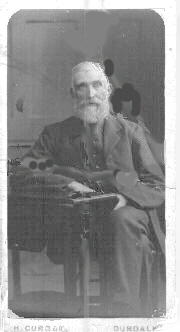 |
Paddie, the Tomany workhorse
prior to 1927
 |
The Tomany name is rare away from the place of family origin in Ireland; the only other known place of possible origin is Bohemia (now the Czech republic) - and they pronounce it the same way. Whether this is coincidence or one branch begat the other at some time in pre-history will have to await some future date - and maybe a DNA comparison between the two groups.
The Tomanys of Croughan owned a small family farm, living from the land. They grew hops for a brewery, and cut squares of peat from a nearby bog - the only available fuel for heating. The 1911 Irish Census shows that the James Tomany farm had a stable, "cow house", "fowl house", and a "piggery" - thus, they raised chickens, swine, and at least one cow, in addition to whatever vegetables were grown for family consumption. Their two-room thatched-roof brick or stone home housed seven people in 1911: James(55) and his wife of 24 years, Catherine (Prunty - 54), sons Michael (18), John (16), and Patrick (9), along with daughters Rose (14) and Margaret (12).
Patrick Tomany and his sister Rose (or Margaret) probably 1912-14
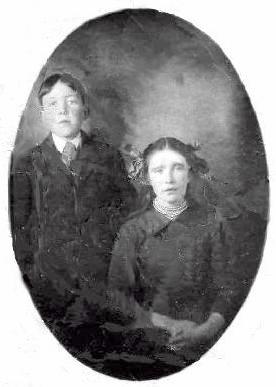 |
The eldest sister, Sarah (20), had emigrated to NYC in 1910. They were, however, not the only Tomanys in tiny Croughan; the census also shows Francis (33) and his wife Annie (32) with a two-year-old son John and an infant Gerard on a second, owned farm; Bridget Tomany (37) was a single owner of third farm in a large (by Croughan standards) three-room home. There even was a second Bridget Tomany (48) visiting the home of farmer Ed (70) and Mary Prunty (52) on census day.
Sarah Tomany's two entries to the US (1910 and 1920) appear in ship's manifests on the Ellis Island website.
By the time of the modern uprisings - which corresponded with the Great War in Europe - "Packy" was a young teen and probably had already had enough of "the Black and Tans". He often told the story of being "shot off a bike" that the British soldiers thought was stolen - and he did tend a deep, oozing wound in his shin every day of his life - a constant reminder of the times. (Whether or not the bike actually was stolen isn't clear !) By 1921, his earlier role of mild reconnaisance and message-running for the then-honorable IRA had graduated to full-fledged membership.
In 1927, Packy's eldest sister,
1927 Passport |
Sarah invited him to come to the US; the Rowans
Patrick Tomany (w/dog), circa 1935
 |
would be his unofficial guides to that place where the "streets were paved with gold": New York. So, armed with a simple letter of recommendation from the village priest ("Patrick is a good boy who has never been in jail..."), Patrick Tomany set out for America. Without skills other than that of a farm worker, one of his first jobs was that of a groundskeeper; he helped landscape the under-construction De Witt Clinton HS in the Bronx. When the depression hit, he was fortunate to have a steady job: elevator operator in the brand-new Chanin Building,
Patrick Tomany and
nephew, Jackie Rowan
circa 1936
 |
directly across the street from "the tallest building in the world" (at the time), Manhattan's Chrysler Building. He kept the job the rest of his life, becoming foreman ("starter") for the daytime crew, and was retained in the late 1950s when the building's elevators converted to pushbutton operation. He was one of a very few men that the elevator repairmen trusted to manuever the car in micro-steps while they were working. Noticing how much more they were paid than he, Dad used to tell me: "Don't operate elevators - repair them, instead. That's where the real money is!". Ultimately, I took his advice on picking a career, specializing in industrial controls and robotics - though not without spending a year in high school working as an elevator operator in the Statler-Hilton Hotel. (I lied about my age; you had to be 18 to operate machinery, including elevators. I was 15.)
THE SCOTS
The Addiewell cart, circa 1915.
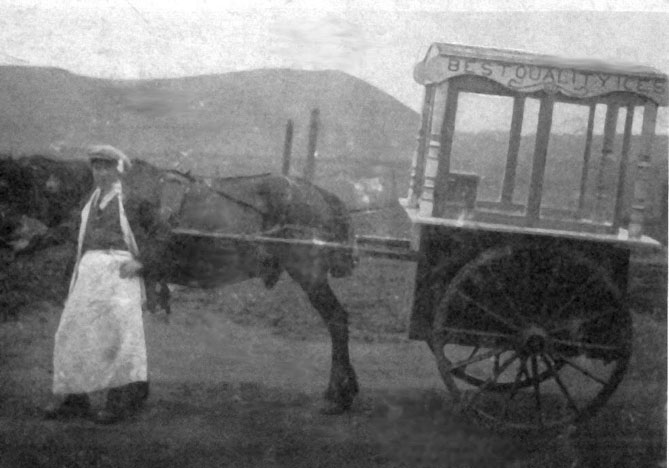 |
On New Year's day 1905, a Glascow "labourer" named James Francis Burns (son of Patrick, a farmer) married Sarah McGuire, daughter of Bernard, an illiterate Irish "hammerman" . James Burns was something of an entrepeneur, and moved his young family to Addiewell, Scotland, there to make his fortune selling food from a horse-drawn cart to shale miners. Successful in business, he opened a "fish and chips" shop there around the time of the first World War - and apparently employed a man to continue operating the cart.
The early 1920s in Scotland were good to the Burns family.
Elizabeth and Mary Burns
Mar 9, 1925
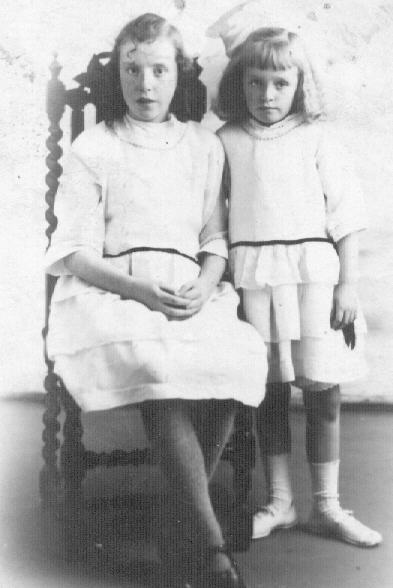 |
So good, in fact that the profitable shop was sold,
St. Pancras School
Addiewell - 1922
Don't miss clicking on this photo !!
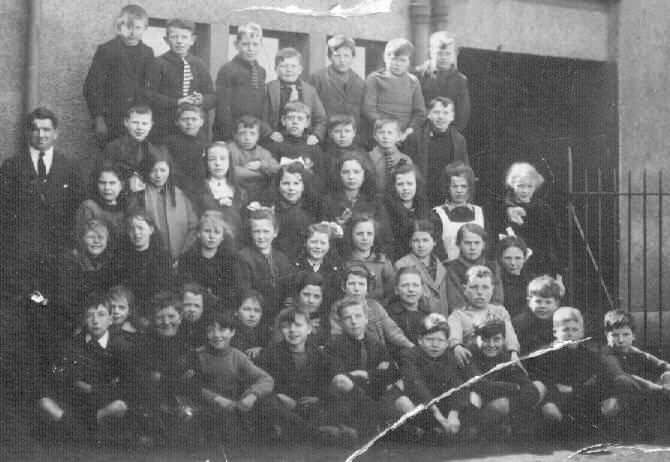 |
financing emigration to Corona, Long Island, and the purchase of a house there. My grandfather Burns went to work for the Anaconda Copper Company as a laborer. There, while cleaning out the smelting chimneys, he discovered that the powdery copper dislodged from the smoke stacks could be mixed with linseed oil to become a brand-new type of paint: metal flake. He had plans to patent the mixture, selling it in two attached cans for mixing at home, but American patent law dictated that as an employee, the rights belonged to the company rather than him. Evidently, the company recognized the value of the metal flake paint formulation, for they immediately granted him promotion to a "lifetime salaried job" of senior foreman, which he held until death. (Such things just don't happen today! - though the same type of patent "non-deal" happened again, two generations later.)
The Burns children, James, Elizabeth("Betty"), Tommy, and Mary were now immigrant American youngsters or teens. When their mother died, Burns remarried within a year - a very unpopular move with the children. James, the oldest, found work as a butler and chauffer for an outrageously-wealthy and influential Irish businessman at the tycoon's winter home in Palm Beach, Florida. It was a rewarding job; James soon purchased an old farm in upstate New York, as well - near one of the boss's haunts in Saratoga Springs. In case you're wondering: James was the majordomo of Joseph P. Kennedy's Palm Beach compound. (Yes, that one! I got to swim in the pool and surf the private beach as a child during a visit in 1958, when the boss was away in Venezuela.)
In 1934, Packy Tomany and Betty Burns met and married, settling in the South Bronx. Young Tommy Burns also married in that decade, and went to work for the railroad, settling in Jackson Heights, Queens. Mary, the youngest Burns, married Jake Beisser, eventually settling in Canoga Park, California.
In 1938, James was born to Packy and Betty Tomany.
Jim Tomany in
Washington D.C.
circa 1960
 |
He would eventually grow to be a husky six feet, two inches as a teen. Jim was an excellent student; well-read, gifted, and perceptive, he received great grades in all his subjects. He attended Cardinal Hayes HS, graduating in 1956. He entered City College, studying to be a Chemical Engineer, but our father's cancer and rapid death forced him to postpone his studies after three semesters. (I was age 11 at the time.)
About ten years after Jim's birth, I was born in 1948.
Patrick and John
Tomany - 1954
 |
A seemingly healthy kid, (but ultimately, an inch shorter), I was the opposite of my brother in almost everything - even though I also scraped through Cardinal Hayes, finishing up in 1966. Fortunately, Jim was a good coach for things academic; he would have been a good coach in sports, too - but for some reason I had no interest in that, either.
Betty and Packy
Tomany - 1958
 |
Where he found solitude, interest and reward, I most often found boredom. I determined quite early that I never would seriously compare siblings to one another; to hear my mother tell it, it was clear that I was destined to become the "black sheep". I was never quite sure whether she thought her prophecy would come true or not. It is a secret she took to the grave - and in a way, it was probably good, for it kept me thinking about it.
"Ah !", you say - wondering why my brother Jim and I, both born in New York, are included here in the "green card" section. Simple, really: The government of Eire considers the children of an Irishman to automatically be Irish citizens, even if "foreign" born. (It isn't unusual; two of my own children - Katie and Paul - were born in Germany - yet are "native born" Americans, able to be elected President.) Since the grandchildren of an Irishman can obtain Irish citizenship via simple application, I guess they too, fall into that category.
Jim and John Tomany, 2001
 |
 Eire Obscura
Eire Obscura  On the Sceptered Isle
On the Sceptered Isle
Photographs and content © 1998,1999 John P. Tomany












